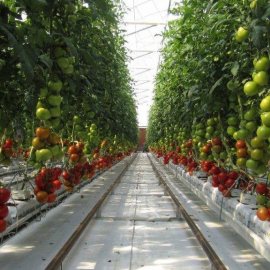Ocean Agriculture
-
English
-
ListenPause
I’m Peter Neill, Director of the World Ocean Observatory.
As the world population continues to grow, we need protein from land and sea in ever-increasing amounts and quality. This has driven us toward genetic modification of seeds, industrial agriculture, dramatic increase in fertilizer development and use, and experiments with aquaculture to replace the protein from the ocean more and more reduced by over-fishing. Each of these is fraught with resistance, consequence, and sometimes abuse that do not necessarily meet the challenge.
What about the ocean and agriculture? As the productivity of the land is decreased or exhausted is there a contribution the ocean can make beyond aquaculture toward sustainable food production worldwide. Let me offer two hopeful examples.
The first is a land-based phenomenon, a process for farming that does not need soil, fossil fuels, groundwater, or pesticides – production even in the desert that is sustained only by sun and seawater. Sundrop Farms is a project in Port Augusta, Australia, a 20 hectare farm that grows tomatoes and other vegetables hydroponically in greenhouses powered by the sun. The system is growing tomatoes in “soil” composed of coconut husks and waste cardboard saturated in seawater with energy for pumps and other electrical support generated by the sun. Today the farm is growing some 18,000 tomato plants – 17,000 metric tons of food already on sale in Australian grocery stores. The system cost over $200 million dollars to build, an intimidating sum. But investors are confident of payback and return by the substantial cost savings by not having to purchase fossil fuel energy in a very expensive market. Expansion is already planned, with the addition of peppers and fruits.
Sundrop is also building new such facilities in similar zones – Portugal in Europe and Tennessee in the United States.What we have here is a fascinating adaptation to the realities of the global energy market and fresh water crisis. There is inherent in the concept, not just reaction, but pro-action, realizing that the market cost of land acquisition and conventional energy, based on oil, can be mitigated by alternative availability of land, reducing expenses dramatically, exploiting the available supply of free sun and seawater, and providing protein at scale to meet, profitably, a worldwide demand.
A second example speaks to the larger question of the availability of arable land. Industrial agriculture, for all its benefit, has nonetheless caused serious detriment to land available for farming. Add to that climate impact of severe weather, drought, and over-consumption by irrigation from the aquifer and ground water supply; add to that the escalating cost of expansion, equipment, and fertilizer, and the nitrate pollution of increased use of that fertilizer; and add to that the impact of hydraulic fracking for oil in farming areas that has caused productive land to be converted to this alternative use, and you have another crisis of aridity, availability, and accountability of traditionally arable land.
So, consider the concept of floating farms, large structures in the ocean, used to complement and expand traditional farming, again exploiting the inexpense of available water—salt or desalinated—and alternative energy from sun and wind, enabling both hydroponic growing and aquaculture, creating new employment for small-scale farmers and fishers, and providing the protein that the exhausted land can no longer. Located in secure areas adjacent to energy and water, protected against sea level rise and extreme weather by seawall and barriers, creating value through labor and reduced cost, floating farms can be constructed now, using available engineering and technology, as a forward-looking investment in long-term food security and resilience.
It is not incorrect to say that these innovations could meet the food demand for the entire world. How can we do otherwise?
We will discuss these issues, and more, in future editions of World Ocean Radio
THE EARTH OPTIMISM SERIES IS BROUGHT TO YOU BY THE WORLD OCEAN OBSERVATORY IN PARTNERSHIP WITH THE SMITHSONIAN INSTITUTION’S OCEAN PORTAL, TO RAISE AWARENESS OF THE GLOBAL EARTH OPTIMISM SUMMIT DURING EARTH DAY WEEKEND, APRIL 21ST THROUGH 23RD, 2017. SHARE YOUR IDEAS AT EARTH OPTIMISM DOT SI DOT EDU.
In this episode we discuss two ideas--floating farms and saltwater agriculture--using ocean and renewable resources toward the goal of sustainable food production worldwide.
This week's episode is a continuation of the Earth Optimism Series, a 24-episode project in partnership with the Smithsonian Institution's Ocean Portal, to celebrate ocean solutions and innovative projects in the context of the Earth Optimism Summit, April 2017.
Image Credit
Sundrop Farms: Growing Tomatoes using Seawater and Renewable Energy
About the Earth Optimism Summit
April 21 - 23, 2017
Washington, D.C.
The Earth Optimism Summit, sponsored by the Smithsonian Institute’s Ocean Portal, will be an unprecedented gathering of thought leaders, practitioners, pioneering scientists and researchers, major civic and industry participants, national and international media, and philanthropists who make up the conservation-minded citizens of our world. They will convene to discuss and share solutions – what are the best minds, boldest experiments, and most innovative community practices telling us about how to preserve biodiversity, protect natural resources, and address climate change?
The Earth Optimism Series is brought to you by the World Ocean Observatory in partnership with the Smithsonian Institution’s Ocean Portal, to raise awareness of the Earth Optimism Summit during Earth Day weekend, April 21-23, 2017 in Washington, D.C. and around the world. Share your ideas at earthoptimism.si.edu.
- Login to post comments



